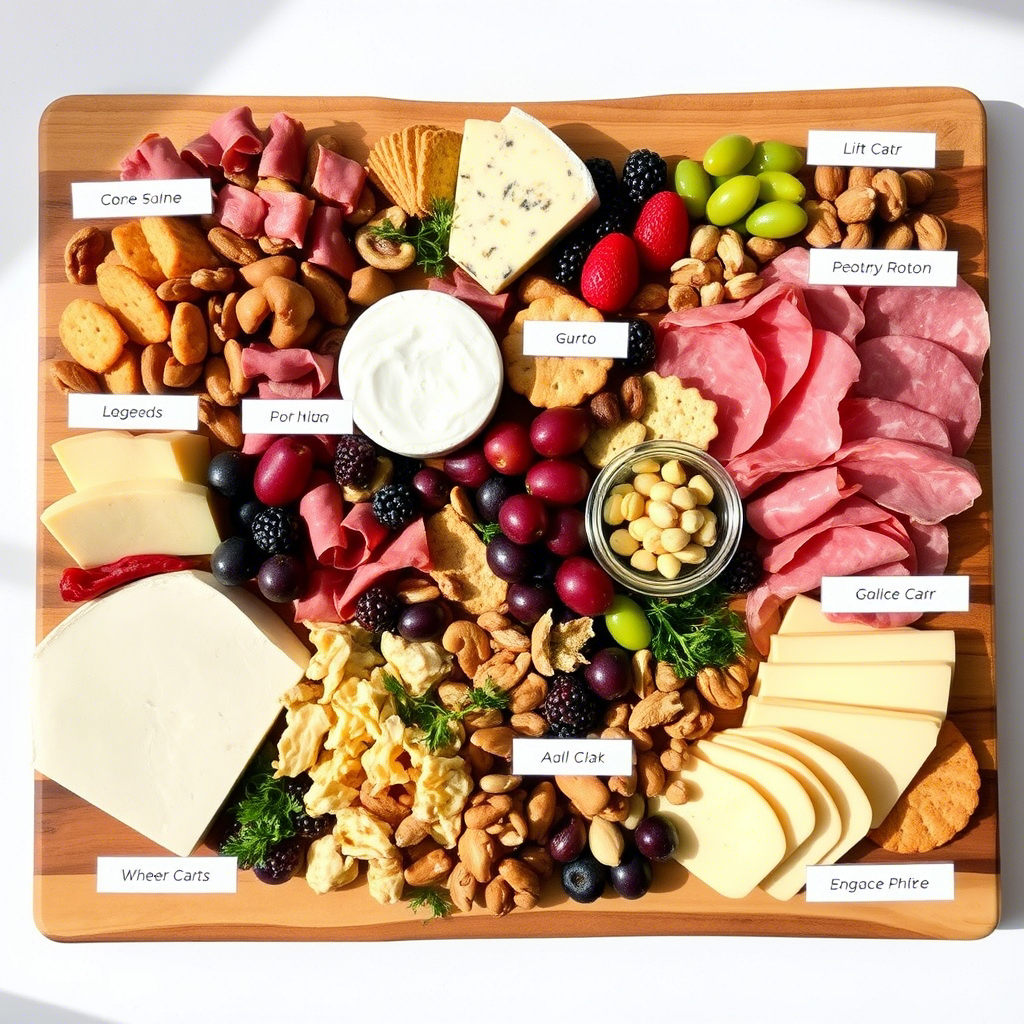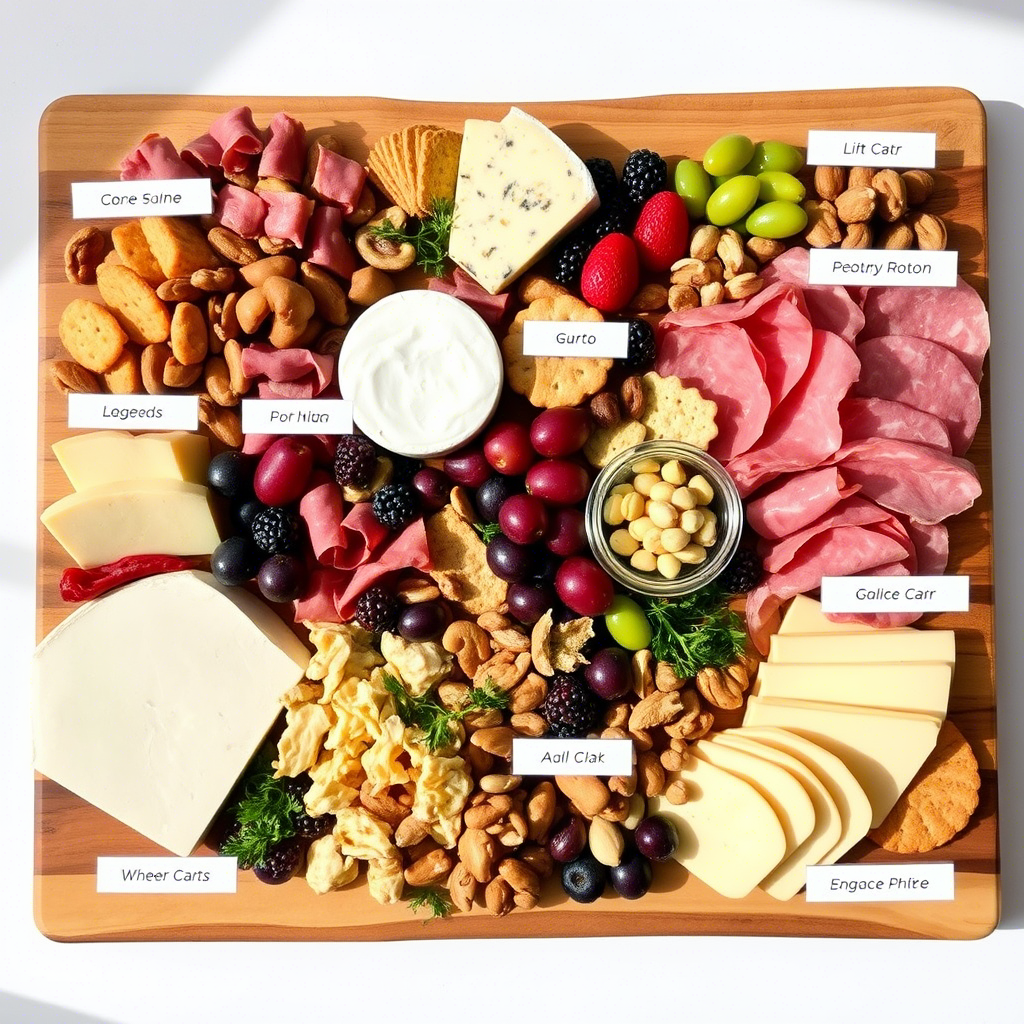Learn how to create a stunning charcuterie board with this step-by-step guide. Perfect for parties, gatherings, or a cozy night in, this guide covers everything you need to know.
Introduction
A charcuterie board is more than just a platter of meats and cheeses—it’s a work of art that delights the eyes and the taste buds. Whether you’re hosting a party, celebrating a special occasion, or simply enjoying a cozy night in, a beautifully crafted charcuterie board is always a hit. In this guide, we’ll walk you through how to create a charcuterie board that’s as visually stunning as it is delicious.
- Why You’ll Love a Charcuterie Board
- What You’ll Need for a Charcuterie Board
- How to Assemble a Charcuterie Board
- Tips for the Perfect Charcuterie Board
- Charcuterie Board Variations
- FAQs About Charcuterie Boards
- Conclusion
- CharcuterieBoard #CheeseBoard #PartyFood #EntertainingIdeas #FoodStyling #GrazingTable #HostingTips #EasyRecipes #FoodPresentation
Why You’ll Love a Charcuterie Board
Charcuterie boards are versatile, customizable, and perfect for any occasion. They’re great for entertaining because they require minimal cooking and can be prepared ahead of time. Plus, they offer something for everyone, from savory meats and cheeses to sweet fruits and nuts.
What You’ll Need for a Charcuterie Board
Here’s a list of essentials to create a show-stopping charcuterie board:
1. The Board
Choose a large wooden board, slate, or platter as the base. Make sure it’s big enough to hold all your ingredients.
2. Meats (Charcuterie)
Select a variety of cured meats for different flavors and textures:
- Prosciutto
- Salami
- Pepperoni
- Chorizo
- Ham
3. Cheeses
Include a mix of cheeses for variety:
- Soft cheeses (Brie, Camembert)
- Hard cheeses (Cheddar, Gouda)
- Blue cheeses (Gorgonzola, Roquefort)
- Fresh cheeses (Mozzarella, Goat cheese)
4. Accompaniments
Add a variety of accompaniments to complement the meats and cheeses:
- Crackers and bread (baguette slices, crostini, gluten-free options)
- Fresh fruits (grapes, berries, apple slices)
- Dried fruits (apricots, figs, dates)
- Nuts (almonds, walnuts, pistachios)
- Olives and pickles
- Spreads (honey, mustard, jam)
5. Garnishes
Use fresh herbs or edible flowers to add a pop of color and elegance.
How to Assemble a Charcuterie Board
Follow these steps to create a beautiful and functional charcuterie board:
1. Start with the Cheeses
Place the cheeses evenly around the board. Cut a few slices or wedges to make it easy for guests to serve themselves.
2. Add the Meats
Fold or roll the meats and arrange them next to the cheeses. Group similar meats together for a cohesive look.
3. Fill in the Gaps
Place crackers, bread, and accompaniments in the empty spaces. Use small bowls or ramekins for spreads and olives.
4. Add Fresh and Dried Fruits
Scatter fresh fruits like grapes and berries around the board. Add dried fruits like figs or apricots for a sweet contrast.
5. Sprinkle Nuts
Add nuts for crunch and texture. Place them in small piles or scatter them across the board.
6. Garnish with Herbs
Use fresh herbs like rosemary or thyme to add a finishing touch. Edible flowers can also add a touch of elegance.
7. Add Utensils
Provide small knives or spreaders for guests to use. Include napkins and plates for easy serving.
Tips for the Perfect Charcuterie Board
- Balance Flavors: Include a mix of sweet, savory, salty, and tangy items.
- Vary Textures: Combine soft cheeses with crunchy nuts and chewy dried fruits.
- Use Color: Incorporate colorful fruits and garnishes to make the board visually appealing.
- Prep Ahead: Assemble the board just before serving to keep everything fresh.
Charcuterie Board Variations
- Mediterranean Board: Focus on olives, hummus, feta, and pita bread.
- Dessert Board: Feature sweet items like chocolate, marshmallows, and fresh fruit.
- Vegan Board: Use plant-based meats, cheeses, and plenty of fresh veggies.
- Holiday Board: Incorporate seasonal flavors like cranberries, spiced nuts, and festive decor.
FAQs About Charcuterie Boards
Here are answers to some of the most common Google questions about charcuterie boards:
Q: How much food should I prepare per person?
A: Plan for 2-3 ounces of meat and cheese per person, along with a variety of accompaniments.
Q: Can I make a charcuterie board ahead of time?
A: Yes! Prep ingredients in advance, but assemble the board just before serving to keep everything fresh.
Q: What’s the best way to store leftovers?
A: Store meats, cheeses, and accompaniments separately in airtight containers in the fridge.
Q: How do I make a vegan charcuterie board?
A: Use plant-based meats, vegan cheeses, and plenty of fresh fruits, veggies, and nuts.
Q: What’s the best board to use for a charcuterie spread?
A: A large wooden board or slate platter works best for both functionality and aesthetics.
Conclusion
Creating a beautiful charcuterie board is an art form that’s both fun and rewarding. With this guide, you’ll have everything you need to assemble a stunning board that’s sure to impress your guests. Whether you’re hosting a party or enjoying a quiet night in, a charcuterie board is the perfect way to elevate any occasion.
📌 Pinterest Title:
“How to Make a Perfect Charcuterie Board – Easy & Stylish Ideas”
📝 Meta Description:
“Learn how to create a stunning charcuterie board with this step-by-step guide. Perfect for parties, gatherings, or a cozy night in. Get tips, ideas, and hosting tricks to impress your guests!”
🏷️ Pinterest Tags:
CharcuterieBoard #CheeseBoard #PartyFood #EntertainingIdeas #FoodStyling #GrazingTable #HostingTips #EasyRecipes #FoodPresentation
Internal Links to Improve SEO
External Links for Authority
- USDA Food Safety Guidelines
- How to Choose the Best Cheeses for a Charcuterie Board
- Tips for Storing Leftover Charcuterie

